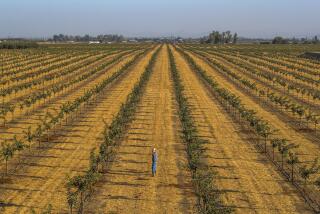Amnesty May Drain Worker Supply : Grower Fears Exodus, to Build Labor Camp
CARLSBAD — Gildardo Garcia knows farm labor. He says he worked 12-hour days for more than 18 months in the fields of northern San Diego County, living largely in crude outdoor dwellings with only a thin sheet of plastic protecting him from the elements.
His description is typical of the atrocious working and living conditions recounted by undocumented farm workers in northern San Diego County, and Garcia says he’s happy to be away from it all. Newly legalized under the farm-worker amnesty provisions of the 1986 immigration law, he has left the fields and is now working the early-morning shift in a taco shop here.
“The restaurant is a lot easier than working in the fields,” concedes Garcia, a soft-spoken 21-year-old from the Mexican state of Oaxaca. “At least I don’t have to work from dawn to dusk, stooping down, picking strawberries or tomatoes, always listening to the patron (boss) yelling at us.”
Garcia’s decision to switch professions illustrates an oft-mentioned fear among Western growers: that newly legalized workers may abandon the farms en masse in search of relatively easier and better-paying jobs in the cities. Such a shift, industry spokesmen say, could create a shortage of workers in California’s $15-billion agricultural industry, which has long been dependent on undocumented labor.
Indeed, a major San Diego agricultural concern, Singh Farms, based in Oceanside, has taken the unusual step of proposing to build a 352-bed labor camp in rural Bonsall--a facility that the grower says is designed to avert a future labor shortage.
Singh Farms says it wants to sweeten the pot to entice newly legalized workers to remain with the company. “We need a stable work force,” explained Daniel Dreger, office manager for Singh Farms. “With the amnesty program going the way it is and with the probability that some workers may be moving into other areas of work . . . we wanted to provide an incentive.”
Farm experts said they can recall no recent case in the state in which a grower proposed building such extensive farm-labor housing. Farm labor camps, once prevalent in California, have generally declined in number since the demise in the 1964 of the bracero program, the World War II-era labor-importation initiative. That program required farmers to provide housing, which was often assailed as deplorable. Growers cite increased costs and heightened government regulation in explaining the drop-off in such camps.
‘They Tend to Close’
“There are certainly very few (camps) being opened, and, if anything, they tend to close,” said Julie Stewart, housing issues manager for the California Department of Housing and Community Development, which licenses such camps.
Fewer than 25% of the up to 300,000 workers in California fields now live in labor camps, according to an estimate by an official of the California Farm Bureau Federation, an industry group.
Consequently, the Singh Farms proposal, still in its early stages, has attracted considerable interest. The company, which farms about 700 acres in San Diego, is proposing construction of two two-story residence buildings, housing a total of 44 sleeping rooms with eight bunks each. Other rooms will be used for dining, laundry, storage and bathrooms, according to a proposal on file with the county planning department.
Fellow growers characterize Singh Farm’s effort as a progressive move that will partly ameliorate the acute problem of farm-worker housing in northern San Diego County, where thousands of laborers squat in rough gullies, arroyos and canyons.
“We applaud the Singh plan,” said Bob L. Vice, a Valley Center nursery owner who is first vice president of the California Farm Bureau Federation. “It’s sorely needed, not only in San Diego but in other areas. There just isn’t any housing for these fellows.”
Others, noting the longtime exploitation of farm workers in California, were less enthusiastic.
“There’s a possibility that the growers had a sudden pang of conscience, but I wouldn’t bet the farm on it,” said Mary Lopez, who directs the immigration program for the Martin Luther King Farm Worker Fund in Keene, Calif.
‘Guest Worker’ Plan
Lopez speculated that Singh may be interested in eventually importing so-called “guest workers,” who may be brought into the United States legally if growers can demonstrate a shortage of legal workers. Although not widely used in California, U.S. authorities have promoted use of the guest worker program, which is officially known as the H-2 or H-2a initiative. However, the program, like the bracero initiative, requires that farmers provide housing--a major hang-up for farmers unwilling to finance expensive labor camps.
Dreger said the new camp is designed to retain existing workers, not to import guest workers. Farm worker advocates have criticized the guest worker program as exploitative and unfair to laborers already in the United States.
Apart from her wariness about guest workers, Lopez, the farm worker advocate, also disputed the central notion behind the camp proposal: that new-found legal status is likely to drive workers away from the fields.
“Generally speaking, most farm workers prefer to be working outdoors,” Lopez said. “When farmers say, ‘They’re going to abandon the farm!’ I say the answer is, ‘Give them a decent wage!’ Instead, they cut wages.”
Although scattered defections of farm workers have been reported, farmers say evidence of a severe labor crunch will probably not be evident in California until 1989, after all eligible farm workers have applied for legal status. Farm experts say that even if shortages do appear, it is unlikely that many growers will resort to the costly alternative of building farm labor housing in an effort to attract workers. More likely, experts say, is that growers will attempt modest wage increases, increased mechanization or will shift to less labor-intensive crops.
As for Gildardo Garcia, while he is happy working in the taco shop for now, he says he wouldn’t turn his back on prospective field labor jobs--particularly if wages were raised and amenities such as housing were included. At the taco shop, he says he earns $4.25 an hour, plus about $7 a night in tips--more than the minimum wage of $3.35 an hour typically offered farm workers.
“It wouldn’t bother me to go back to farm work--if the pay was good, there were some benefits and the boss wasn’t always yelling and abusing the workers,” said Garcia, a bachelor, who said he hasn’t been back to his home in Mexico since he crossed into the United States illegally more than two years ago.
More to Read
Sign up for Essential California
The most important California stories and recommendations in your inbox every morning.
You may occasionally receive promotional content from the Los Angeles Times.










